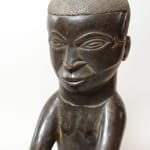Kuba Wooden Palm Wine Cup, 20th Century CE
Wood
42.5 x 13 cm
16 3/4 x 5 1/8 in
16 3/4 x 5 1/8 in
PF.5719
Further images
Palm wine, obtained from the raffia palm tree, is the most popular beverage consumed in the areas inhabited by the Kuba tribe. Today, plastic cups or glasses are used for...
Palm wine, obtained from the raffia palm tree, is the most popular beverage consumed in the areas inhabited by the Kuba tribe. Today, plastic cups or glasses are used for drinking it; however, during the 19th and early 20th centuries, decorated wooden cups were carved by several tribes across the Southern Savanna. The Kuba specifically are known for their figural and cephalomorphic (head-shaped) cups. This vessel is a perfect example of the masterful artistry of the Kuba woodcarvers. Surely, this rare cup must have been the possession of important dignitary. While the head of this sculpture is traditional, the body and base are exceptional. Most figural Kuba wine cup depict truncated, abstracted bodies. However, here the body is represented in full, sitting atop an antelope. Riding in itself was considered a mark of distinction, both in respects to leisure and power. When one rides, one need not walk like the common masses. As well, the image of the rider can be associated with the king, for a rider controls the wild beast much like the king controls his empire. The naturalism of the sculpting is extraordinary. From the characteristic hairstyle with a flat hairline and angles at the temples, to the tail that curves into the handle. A cup such as this was certainly originally carved as a prestigious display piece for titled individuals of the Kuba tribe. Surely the vessel’s inherent beauty and functional durability rival or surpass that of any fine crystal stemware or bejeweled chalice.









